

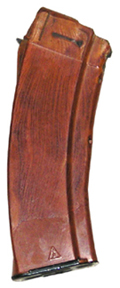 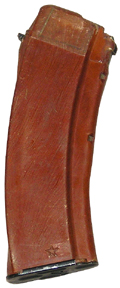
|
BAKELITE 30rd Manufacturers: Izhmash (left) and Tula (right) Frequency: Uncommon (Izhmash), Rare (Tula) Description: The first Russian 5.45mm magazine type produced. Constructed from AG-4 phenolic resin (commonly known as "Bakelite") with metal lip reinforcement, rear locking lug and floorplate. Distinctive mottled orange color. Arsenal mark on right side, mold number on left, near bottom of magazine body. Some examples may bear a small white "Made in Russia" sticker. Izhmash produced these magazines for the AK-74 and AKS-74 rifles; Tula produced them for the AKS-74U carbine. This magazine type was officially replaced in the early 1980s, but large numbers are still in front-line service with Russian military forces. Notes: Similar to E. German 30rd Bakelite, but generally darker in color with more pronounced streaking/mottling. Some of these magazines were painted black, allegedly to help differentiate between the Bakelite 5.45 and 7.62 mags when both were simultaneously in widespread use. Examples have been seen with silver ink acceptance stamps applied over the black paint, indicating the painting was done at the factory. |
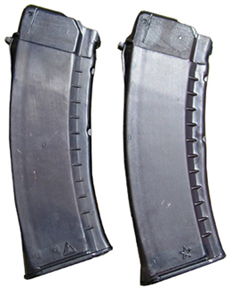
|
SHINY PLUM 30rd Manufacturers: Izhmash (left) and Tula (right) Frequency: Common (Izhmash), Common (Tula) Description: The second Russian 5.45mm magazine type to be developed; Izhmash produced these magazines for the AK-74 and AKS-74 rifles; Tula produced them for the AKS-74U carbine. Polymer construction with metal lip reinforcement, rear locking lug and floorplate. Shade varies from maroon to near black; exterior finish can be gloss to semi-gloss. Small horizontal reinforcing ribs run down both sides of the magazine body near the front. Arsenal mark on right side, mold number on left, near bottom of magazine body – mold numbers for this type range up to the low 40s. A black overspray may be present on the top and bottom sections or over the entire magazine; this was allegedly done to protect the metal parts from corrosion. Notes: Similar to Russian (Izhmash) 30rd Matte Plum; some overlap in mold numbers. May be quite difficult to distinguish the two types except under certain lighting conditions. Some examples have been "sanitized" by grinding away the arsenal mark; this significantly reduces the collector value of the magazine. Very early (single-digit mold number) magazines of this type have been seen with metal followers and floorplate inserts (see pic in Comparison Photos section below). Magazines imported via Bulgaria may contain brown Bulgarian internals. |
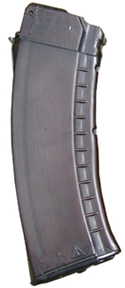
|
MATTE PLUM 30rd Manufacturer: Izhmash Frequency: Common Description: The third Russian 5.45mm magazine type produced. Polymer construction with metal lip reinforcement, rear locking lug and floorplate. Shade varies from maroon to near black, with a non-reflective satin finish. Small horizontal reinforcing ribs run down both sides of the magazine body near the front. Arsenal mark on right side, mold number on left, near bottom of magazine body – mold numbers for this type range from the low 40s up. A black overspray may be present on the top and bottom sections or over the entire magazine; this was allegedly done to protect the metal parts from corrosion. Notes: Similar to Russian (Izhmash) 30rd Shiny Plum; some overlap in mold numbers. May be quite difficult to distinguish the two types except under certain lighting conditions. Some examples have been "sanitized" by grinding away the arsenal mark; this significantly reduces the collector value of the magazine. Also, magazines imported via Bulgaria may contain brown Bulgarian internals. |
| TRUE BLACK 30rd Manufacturer: Izhmash Frequency: Uncommon Description: Current-production magazine for the AK-74M and AK-105. PA-6 thermoplastic (commonly known as nylon) construction with metal lip reinforcement, rear locking lug and floorplate. Color is dead black with no purple/maroon undertone; exterior finish is non-reflective satin. Small horizontal reinforcing ribs run down both sides of the magazine body near the front. Arsenal mark on right side, mold number on left, near bottom of magazine body – mold numbers for this type range from high 40s up. Notes: Similar to Russian (Izhmash) 30rd Matte Plum; some overlap in mold numbers. May be quite difficult to distinguish between the two types by color alone, except under certain lighting conditions. True Black mags can be identified by the presence of a "4" ink stamp near the front locking lug, where plum mags will show an "M" stamp. Also similar to Bulgarian and Polish 30rd Black Poly types, except for markings. Example shown has been "demilled" by grinding off the feed lips; it was used for demo purposes at the SHOT Show in 2005. |
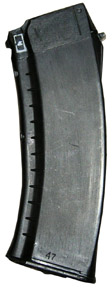
|
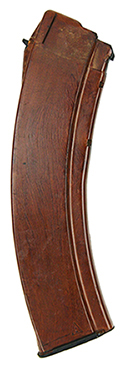
|
IZHMASH BAKELITE 45rd Manufacturer: Izhmash Frequency: Rare Description: What makes this magazine particularly unusual is the fact that the production of 45rd Bakelite units were assigned to Molot. It appears that for a time, Izhmash produced some as well. To date, only a few have surfaced, making this particular variation quite rare and almost qualifying it as an exotic. Manufactured for the RPK-74 light machinegun, but usable in all 5.45x39 caliber AK rifles and carbines. Constructed from AG-4 phenolic resin (commonly known as "Bakelite") with metal lip reinforcement, rear locking lug and floorplate. The earliest Izhmash Bakelite magazines have a darker brown/orange color, while other later examples are more orange in shade. Izhmash arsenal mark on right side, mold number on left, near bottom of magazine body. Approximately 1/3 longer than a 30rd magazine. (Photos courtesy of Phil Steinschneider) Notes: Identical to Molot 45rd Bakelite, except for the presence of the Izhmash arsenal mark and a darker overall color for the earliest observed examples. |
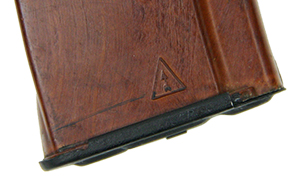 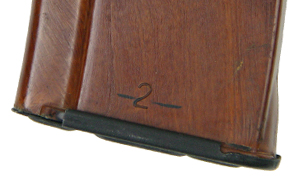
|
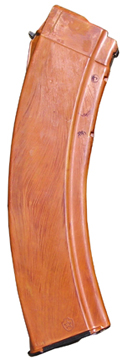
|
BAKELITE 45rd (left) Manufacturer: Molot (Vyatskie Polyany Arsenal) Frequency: Common Description: Just like the Izhmash version above, but produced in much larger quantities because Molot was tasked with producing the vast majority of them. They were manufactured for the RPK-74 light machinegun, but usable in all 5.45x39 caliber AK rifles and carbines. Constructed from AG-4 phenolic resin ("Bakelite") with metal lip reinforcement, rear locking lug and floorplate. Distinctive mottled orange color. Molot arsenal mark on right side, mold number on left, near bottom of magazine body. Notes: Identical to Bulgarian 45rd Bakelite, except for the presence of Molot arsenal mark. Some examples have been "sanitized" by grinding away the arsenal mark; this significantly reduces the collector value of the magazine. RIBBED PLUM 45rd (right) Manufacturer: Molot (Vyatskie Polyany Arsenal) Frequency: Uncommon Description: Manufactured for the later-model RPK-74 light machinegun, but usable in all 5.45x39 caliber AK rifles and carbines. Polymer construction with metal lip reinforcement, rear locking lug and floorplate. Color is dark plum with black overspray at top and bottom; nonreflective satin finish. Large horizontal reinforcing ribs run down both sides of the magazine body and span almost the entire width. Arsenal mark on right side, mold number on left, at bottom rear corner of magazine body. Approximately 1/3 longer than a 30rd magazine. |
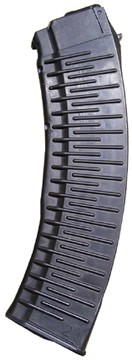 |
| RUSSIAN RIBBED "TRUE BLACK" 45rd Manufacturer: Molot (Vyatskie Polyany Arsenal) Frequency: Uncommon Description: Current production magazine for the RPK-74M light machinegun. Identical to the 45rd Ribbed Plum type described above, but dead black in color. This type was virtually unknown outside of Russia due to that country's restrictions on export and civilian ownership of military items. In the mid 2010s these began to be imported into the United States, only to be banned in 2017 when sanctions initially imposed on Izhmash were extended to Molot. (Photo courtesy of Rob Stott: 45rd Ribbed Plum mag on left, 45rd True Black mag on right.) |
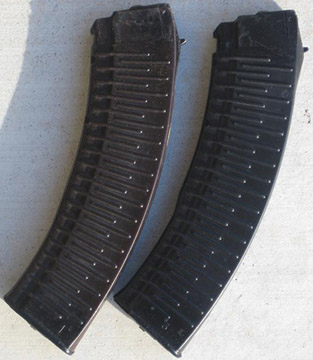
|
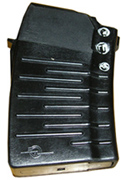
|
RIBBED BLACK (VEPR) 10rd Manufacturer: Molot (Vyatskie Polyany Arsenal) Frequency: Scarce Description: Built for the export-model 5.45x39 "VEPR" hunting rifle but capable of being used in other 5.45x39 caliber AK rifles and carbines, this magazine is largely similar in design and construction to the 45-round ribbed plum and black RPK-74 magazines described elsewhere in this Guide. Features include polymer construction with metal lip reinforcement, rear locking lug and floorplate, and large horizontal reinforcing ribs running down both sides of the magazine body and spanning almost the entire width. Color is dead black with a smooth, semi-reflective finish. Markings include Molot company logo (as opposed to the star-in-shield arsenal mark) on right side of magazine body and large "5,45" caliber designation on left side, both in the lower rear corner. A small mold number appears on the left side, forward of the caliber marking. Floorplate is of a recessed or internal design, differing from all other 5.45 Kalashnikov magazines. Magazine body has rounded edge at bottom rear rather than the slight outward flare found on other polymer types. Notes: It is unclear how many of these magazines are in the US or how they got here, as the sole American importer of the VEPR line did not bring them in, opting instead to provide 30rd Bulgarian or East German AK-74 magazines with their rifles. The Molot web site also lists a 5rd magazine for the 5.45 VEPR; it is assumed to be similar. |
| BLACK POLY 30rd Manufacturers: Arsenal Inc., NITI Kazanlak and Optico-Electron Frequency: Common (Arsenal Inc. Code 10), Common (NITI Kazanlak Code 21) Uncommon (Optico-Electron Code 25) Description: Probably the 5.45mm magazine type most frequently encountered in the US. Construction closely follows the Russian design - polymer body with small horizontal reinforcing ribs down both sides near the front, and metal lip reinforcement, rear locking lug and floorplate. Color is dead black with a non-reflective matte finish. Notes: Similar to Russian True Black and Polish Black Poly types, except for markings. NITI Kazanlak Code 21 magazines are frequently encountered with brown replacement part followers and floorplate inserts. Optico-Electron Code 25 magazines appear to be constructed from a harder type of polymer with a much smoother texture than Arsenal Code 10 or NITI Kazanlak Code 21 magazines. NITI (Bulgarian acronym for "Science, Research & Technology Engineering") Kazanlak was the former research & development branch of Arsenal Bulgaria, and became a separate state-owned entity when Arsenal became a private corporation. |
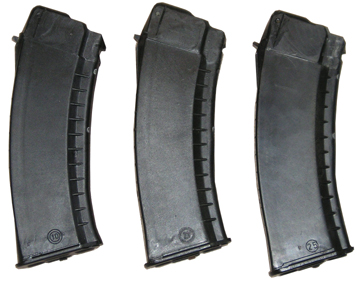 |
| PLUM & OD GREEN POLY 30rd Manufacturer: Arsenal Inc. Frequency: Uncommon Description: In late 2006,K-VAR Corporation (a US affiliate of Arsenal Inc.) commissioned Arsenal to produce a run of plum and OD green AK-74 magazines for the US commercial market. Except for the colors, these magazines are identical to the Code 10 black polymer type described above. The plum and OD colors match the polymer stock sets offered by K-VAR. Notes: It is unknown how many of these colored magazines were or will be produced. Because of this and because K-VAR is the sole importer, the frequency value of "Uncommon" was assigned. |
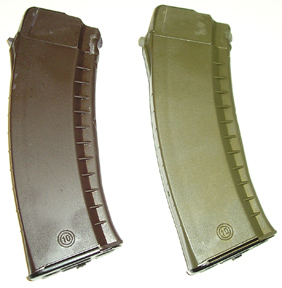 |
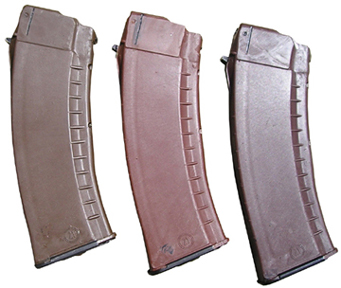
|
BROWN / SADDLE TAN / FIREBRICK RED POLY 30rd Manufacturer: NITI Kazanlak (Brown/Saddle Tan/Firebrick Red) and Optico-Electron (Firebrick Red only) Frequency: Common (NITI Kazanlak Code 21 Brown), Uncommon (NITI Kazanlak Code 21 Saddle Tan & Firebrick Red), Scarce (Optico-Electron Code 25 Firebrick Red) Description: Construction is identical to the Black Poly magazines described previously. It is unknown whether the color nomenclature is official, or simply made up by US vendors/consumers in an effort to better describe the variations (that is, they could all be considered "brown" by the manufacturer). Whichever the case, all three colors show wide ranges: Brown can run from dark chocolate to a lighter mocha; Saddle Tan can run from medium brown to burnt orange, and Firebrick Red can be anything from reddish-brown to maroon. Complicating matters even more is that the colors can appear differently as lighting conditions change. Notes: All three colors commonly have black ink splotches on the magazine body, and may be encountered with brown replacement part followers and floorplate inserts. Optico-Electron Code 25 magazines appear to be constructed from a harder type of polymer with a much smoother texture than the NITI Kazanlak Code 21 magazines. NITI (Bulgarian acronym for "Science, Research & Technology Engineering") Kazanlak was the former research & development branch of Arsenal Bulgaria, and became a separate state-owned entity when Arsenal became a private corporation. |
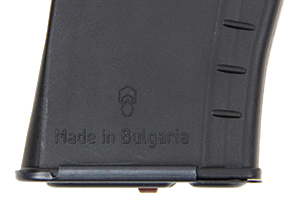 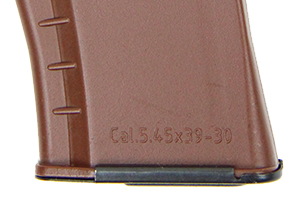
|
BROWN / BLACK COMMERCIAL 30rd Manufacturer: ISD Bulgaria Ltd. Frequency: Plentiful Description: Construction is commercial grade, with metal reinforcement only found at the feed lips. Both the front and rear locking lugs are made of poly, which clearly distinguishes this type from military surplus magazines. The bottom right side has raised letters indicating that they are "Made in Bulgaria." Markings on the left side show caliber and capacity of "Cal. 5.45x39-30." Notes: Both types are plentiful and available from various online dealers on a regular basis. The brown and black colors are consistent on all observed samples, with both available in equal quantities. The black variation appears to be more popular and is sometimes sold for a slightly higher price. |
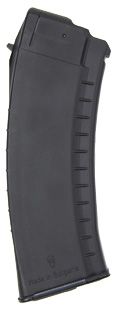 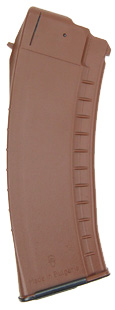
|
 BAKELITE 45rd
BAKELITE 45rd
Manufacturer: Unknown; probably Molot
Frequency: Uncommon
Description: Manufactured for the RPK-74 light machinegun, but usable in all 5.45x39 caliber AK rifles and carbines. Constructed from AG-4 phenolic resin (commonly known as "Bakelite") with metal lip reinforcement, rear locking lug and floorplate. Distinctive mottled orange color. Empty disc on right side, mold number on left, near bottom of magazine body. Approximately 1/3 longer than a 30rd magazine.
Notes: Identical to Russian 45rd Bakelite except for the absence of Molot arsenal mark; Bulgarian RPK-74 magazines were most likely produced by Molot in Russia under contract. These are more commonly encountered and bring far lower prices than the arsenal-marked Russian equivalent.
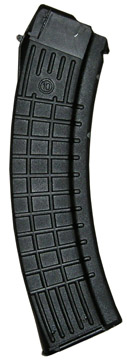 BLACK WAFFLE
45rd
BLACK WAFFLE
45rd
Manufacturer: Arsenal Inc.
Frequency: Uncommon
Description: Polymer construction with metal lip reinforcement, rear locking lug and floorplate. Features five vertical reinforcement ribs at the top and bottom of the magazine, with the 2nd and 4th ribs running the full length of the mag body. These intersect with horizontal ribs along the magazine's midsection, creating a distinctive "waffle" pattern similar to that found in Arsenal's 7.62x39 and 5.56x45 AK magazines. The horizontal ribs wrap around to the spine of the magazine, but not to the front. Color is dead black with a slightly reflective textured finish. Arsenal mark appears on the upper right side of the magazine, just above the first horizontal rib. Approximately 1/3 longer than a 30rd magazine.
Notes: First appearing in March 2008, these magazines were produced at K-VAR's request specifically for the US commercial market, as had previously been done with the plum and OD green 30rd magazines (see above). Because it is unknown how many of these magazines were or will be manufactured, and because K-VAR is the sole importer, the frequency value of "Uncommon" was assigned.

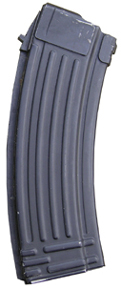
|
STEEL 30rd Manufacturer: Lucznik (Radom) Frequency: Common Description: Manufactured for the wz.88 "Tantal" assault rifle, the Polish equivalent to the AK-74. All-steel construction with large vertical ribs and smaller interlocking horizontal ribs on the sides of the body, and a prominent dorsal spine. Semi-gloss, slightly rough black finish (painted). No arsenal logo or proof marks evident. Notes: Generally similar in construction and appearance to Eastern Bloc AKM (7.62x39) magazines, but with a straighter profile. Nearly identical to the less common Romanian 30rd 5.45 magazine, except for slight differences in the spine, feed lip reinforcement area and finish. |
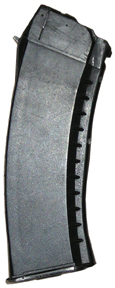
|
BLACK POLY 30rd Manufacturer: Lucznik (Radom) Frequency: Common Description: Manufactured for the wz.88 "Tantal" assault rifle, the Polish equivalent to the AK-74. Construction closely follows the Russian design - polymer body with small horizontal reinforcing ribs down both sides near the front, and metal lip reinforcement, rear locking lug and floorplate. Color is dead black with a slightly reflective finish. Mold number appears on the left side of the magazine body near the bottom. No arsenal mark is present, though a small diamond-shaped proof stamp may be found on the spine just above the floorplate. Notes: This is the early type Tantal magazine; later versions are marked with the caliber designation and show other minor differences (see below). Because they are a relatively obscure type and lack markings save for the mold number, these early Tantal magazines are often misrepresented by sellers as Bulgarian, Russian or East German. |
| BLACK POLY w/ CALIBER MARKING 30rd Manufacturer: Lucznik (Radom) Frequency: Uncommon Description: Manufactured for the wz.88 "Tantal" assault rifle, the Polish equivalent to the AK-74. Construction closely follows the Russian design - polymer body with small horizontal reinforcing ribs down both sides near the front, and metal lip reinforcement, rear locking lug and floorplate. Color is dead black with a frosted/textured finish. Mold number appears on the left side of the magazine body near the bottom, and caliber designation "5,45x39" appears on the left side roughly parallel to the rear locking lug. No arsenal mark is present. Notes: This is the later type Tantal magazine, marked with the caliber to distinguish it from the nearly identical wz.89/96 magazine (which is marked "5,56x45"). The caliber-marked Tantal magazines also lack the proof mark and drain hole found on the spine of the earlier types. |
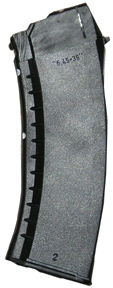
|
| STEEL 5rd Manufacturer: Cugir Arsenal Frequency: Rare Description: Created for the US commercial market during the "Assault Weapons Ban" era and supplied with the CUR-2, the first type of 5.45 rifle imported by Century Arms International in the mid-1990s. These appear to have been fabricated by cutting down a 30rd steel magazine. When Century Arms transitioned from importing the thumbhole-stocked, all-Romanian CUR-2 to the pistol-gripped, 922(r) compliant SAR-2 in the late 1990s, the 5rd magazine was discontinued in favor of a 10rd steel magazine (see below). 5rd steel magazines of this type can occasionally be found for sale on the secondhand market, and retain some value as curiosities and collectors' items. Their short length also makes them convenient when shooting from a bench rest. |
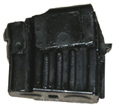
|
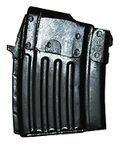
|
STEEL 10rd Manufacturer: Cugir Arsenal Frequency: Uncommon Description: Created for the US commercial market during the "Assault Weapons Ban" era and supplied with the SAR-2 5.45 rifles imported by Century Arms International in the late 1990s and early 2000s. These appear to have been fabricated by cutting down a 30rd steel magazine of the type described below. Century Arms stopped furnishing the 10rd magazines with their rifles in about 2002 (switching to East German 30rd Bakelites, then to Bulgarian 30rd polymer types), and the sunset of the AWB in 2004 largely eliminated demand for them in the US. They can occasionally be found for sale on the secondhand market, and retain some value as curiosities and collectors' items. Their short length also makes them convenient when shooting from a bench rest. |
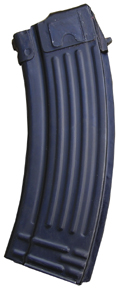 STEEL 30rd
STEEL 30rd
Manufacturer: Cugir
Arsenal
Frequency: Uncommon
Description: All-steel construction with large vertical ribs and smaller interlocking horizontal ribs on the sides of the body, and a prominent dorsal spine. Semi-gloss, smooth black finish (blued). A small chevron or arrowhead shape and other proof marks may be present on the dorsal spine.
Notes: Generally similar in construction and appearance to Eastern Bloc AKM (7.62x39) magazines, but with a straighter profile. Nearly identical to the more common Polish Tantal 30rd steel magazine, except for slight differences in the spine, feed lip reinforcement area and finish.
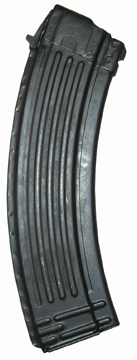 STEEL 40rd
STEEL 40rd
Manufacturer: Cugir Arsenal
Frequency: Scarce
Description: Intended for use with the Romanian RPK-74 light machinegun, but compatible with all 5.45x39 caliber AK rifles and carbines. Construction, finish and identifying features are identical to the 30rd magazine described above, with the RPK magazine being about 25% longer.
Notes: Generally similar to the Eastern Bloc RPK (7.62x39) 40rd magazine, but much straighter in profile.
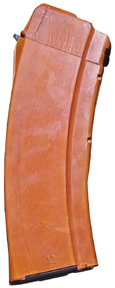
|
BAKELITE 30rd Manufacturer: Unknown, but likely Ernst Thälmann VEB Frequency: Common Description: Second most common type of 5.45 magazine encountered in the United States; huge numbers of these were released into the surplus market after the reunification of Germany in the early 1990s, and new-condition examples could be had for as little as $3.00 apiece at one point. In recent years, supplies have tightened and prices have gone up, but there are still plenty of these magazines to be had, and they are still used as OEM magazines by at least two US manufacturers/importers. Constructed from AG-4 phenolic resin (commonly known as "Bakelite") with metal lip reinforcement, rear locking lug and floorplate. Distinctive orange color. Mold number on right side near bottom of magazine body; no arsenal mark present. Some examples may bear a small white "Made in Germany" sticker. Notes: Similar to Russian 30rd Bakelites, but generally lighter in color with less pronounced streaking/mottling. Robinson Armament uses East German Bakelites coated in a textured black finish as OEM magazines for their VEPR rifles; beware of these being misrepresented on the secondhand market. Lack of reinforcement ribs and arsenal marks, and the presence of the mold number on the right side rather than the left will distinguish these black EG Bakelites from the Bulgarian, Russian and Polish polymer mags. Also, EG Bakelites modified by Century Arms for use with .223 (5.56x45) rifles can be distinguished by a band of black paint around the top of the magazine and a large white identification sticker on the magazine body. |
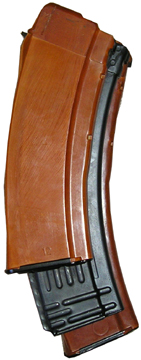
|
Relative size of 30, 40 and 45rd 5.45x39mm Kalashnikov magazines |
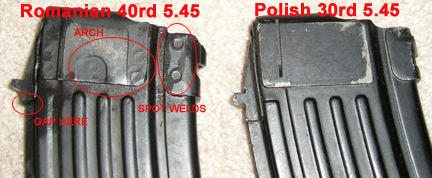
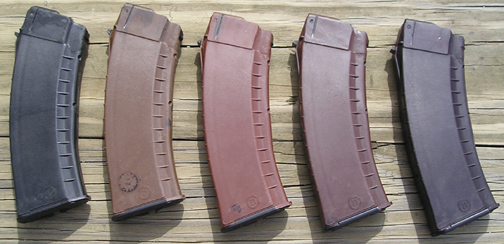
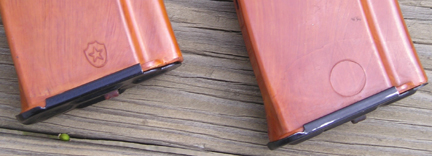
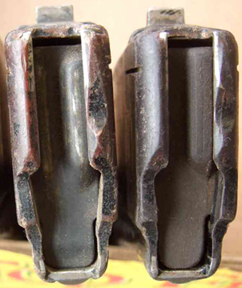
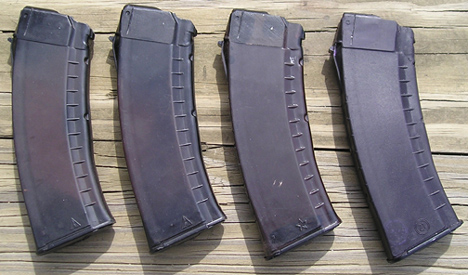
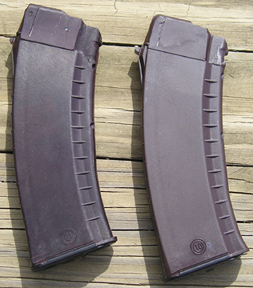
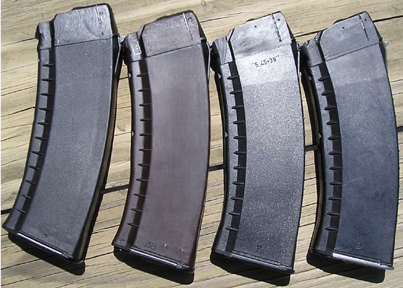
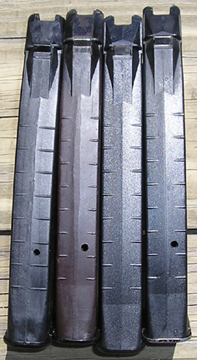
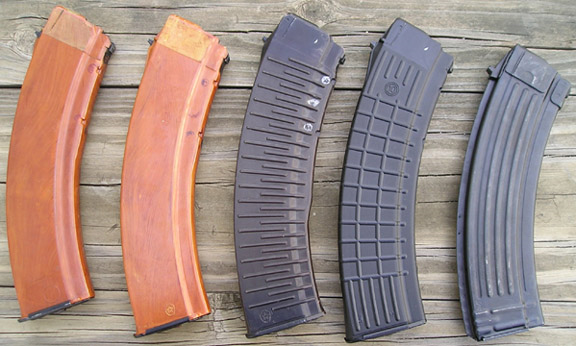
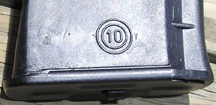
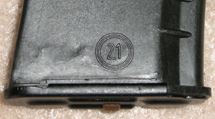
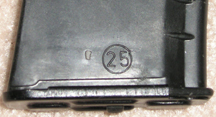

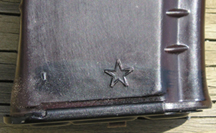
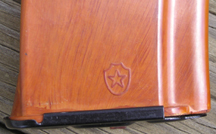
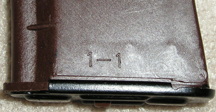
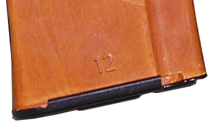
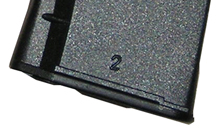
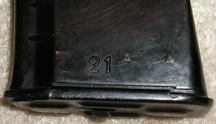
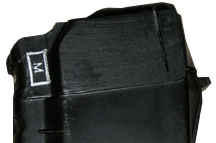
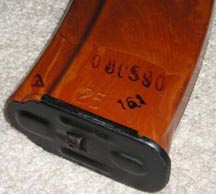
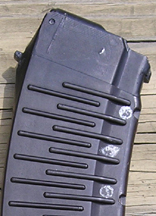
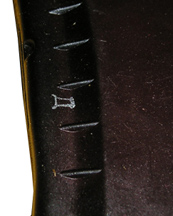

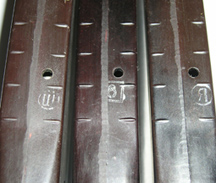

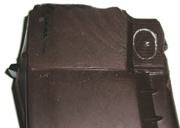
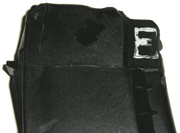
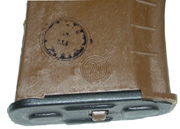
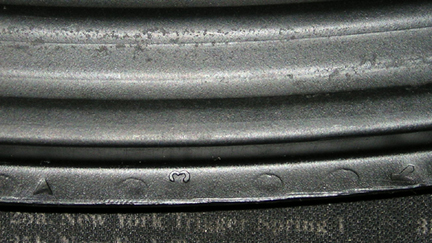
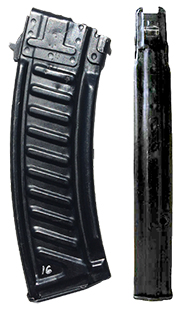
|
RUSSIAN PROTOTYPE ALUMINUM 30rd Description: Ostensibly developed for the prototype AL-7 assault rifle, this lightweight aluminum magazine has also been observed in several other early rifle prototypes, including the Korobov TKB-072, Korobov TKB-072-1, and Korobov 5.45/12.7mm machinegun 80.002. Even rarer than the pre-production glass-filled magazine seen below, some of these have become available in the US, but of course demand premium prices. (Right side photo courtesy and © 2016 Ryan Ross Collection with back side photo acquired from an article covering history of the 5.45x39 round Part 2: A Difficult Destiny) |
| RUSSIAN PROTOTYPE ALUMINUM 40rd Description: Similar to the 30rd magazine above, the 40rd lightweight aluminum magazine was probably developed to compliment prototype rifles needing higher capacities. Also like the 30rd version, a few have made it into the US for those lucky enough to find and afford them. (Photo courtesy of an anonymous donor) |
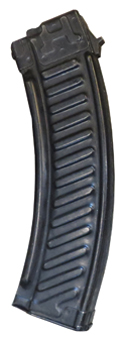
|
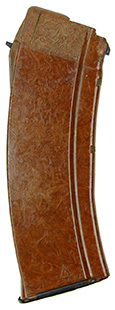
|
RUSSIAN IZHMASH EARLY PRODUCTION GLASS-FILLED POLYAMIDE 30rd Description: This is one of the earliest of all AK-74 magazines and probably represents the first units made by the factory during the early production phase in the early seventies. They were likely used for the initial field trials and are only seen very infrequently. It bears a unique look due to its unusual construction. Instead of Bakelite, it features a "flakey" or "mottled" structural appearance indicative of glass-filled polyamide. The magazine pictured here was included in a batch of standard Russian Bakelite magazines imported in 2015. Of the hundreds of units brought in with that shipment, it is the only one known to have surfaced. Therefore, the Russian Izmash early production 30rd is one of the few "exotic" 5.45 magazines that is remotely obtainable. (Photo courtesy of Phil Steinschneider) |

|
RUSSIAN IZHMASH EARLY PRODUCTION GLASS-FILLED POLYAMIDE 20rd Description: Just like its 30rd cousin above, the 20rd early production magazine is made of glass-filled polyamide, and appears to have at least been used during the development of the AKS-74U shorty assault rifle, which was designed for use by vehicle crews and in other applications requiring maximum compactness and maneuverability. The shorter length is also handy when shooting off a bench. This is another of those unobtainable "exotics" that will unlikely reach US shores anytime soon. (Left: Photo courtesy of Kalashnikov Arms © 1997 Rosvoorouzhenie. Right: Photo courtesy of an anonymous donor.) Notes: In the book, Kalashnikov Arms, the grip of the AKS-74U appears black, so it has been enhanced to the correct plum in these photos. |
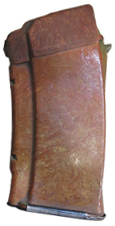
|
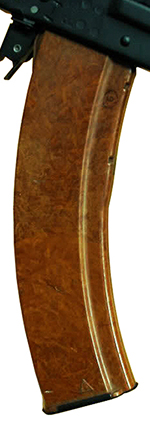
|
RUSSIAN IZHMASH EARLY PRODUCTION GLASS-FILLED POLYAMIDE 45rd Description: Very similar to the 30rd version, this 45rd magazine represents the first units made by the factory during the early production phase in the early seventies out of glass-filled polyamide. (Left: Photo courtesy of "Red*Dawn" on the The AK Forum) The photo on the right shows one of these magazines fitted to an experimental light machinegun. (Right: Photo courtesy of Kalashnikov Arms © 1997 Rosvoorouzhenie) |
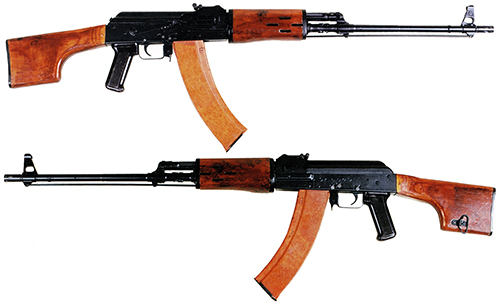 |
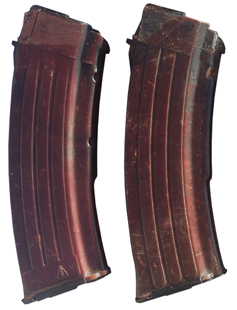
|
RUSSIAN VERTICAL RIBBED PLUM POLYAMIDE PROTOTYPE (Russian Plum Ribbed) 30rd Description: A new requirement was issued by the Soviet defense ministry around 1973 for a new compact machinegun. This started a competition among Russian arms manufacturers and design bureaus to create a new weapon to meet those requirements. By 1977 TsNIITochMash (Central Scientific - Research Institute of Precise Mechanical Engineering Related to Rostec) had developed a candidate weapon dubbed the "MA," or Malogabaritnyj Avtomat. The MA compact assault rifle took advantage of the exotic polymer research in which this facility specialized. These polyamide magazines were part of that program. Limited numbers of these mags were issued to motorized and airborne divisions taking part in the AKSU field trails held in Kirovabad circa 1976/77. Izhmash apparently molded some of their own of this exact variation; hence, the factory marks on a few examples. Those without factory marks were probably transferred directly from the pilot-production facilities at TsNIITochMash and were part of the initial pre-production batch. This would explain the low numerical serial numbers (with parenthetical notations) hen-scratched into various documented examples. The format seems to indicate a low volume unit number followed by a batch number. (Left: Photo courtesy k.rowe2516 on The AK Files. Right: Photo courtesy of Pavel P. "ptica" on www.ak-info.ru with text paraphrased from Doug "Tantal" on The AK Forum.) |
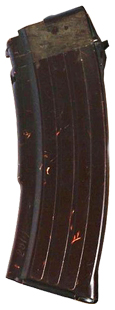
|
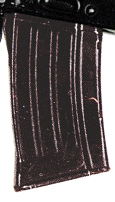 |
RUSSIAN VERTICAL RIBBED PLUM POLYAMIDE PROTOTYPE (Russian Plum Ribbed) 20rd Description: Similar to the 30rd vertical ribbed plum polyamide magazine above, this smaller cousin was noted on an AKS-74U shorty assault rifle pictured with a PBS-4 silencer. The original photo of the mag makes what would be a plum grip and magazine appear black, so the photo to the left was enhanced to make it appear more like the 30rd plum unit above. (Photos courtesy of Kalashnikov Arms © 1997 Rosvoorouzhenie) Notes: In the book, Kalashnikov Arms, the furniture and magazine of the AKS-74U appear black, so they have been enhanced to an approximate plum in these photos. |

|
| RUSSIAN MULTI-RIBBED PLUM POLYAMIDE PRE-PRODUCTION (Russian Plum Waffle) 30rd Extremely similar to the vertical ribbed plum polyamide prototype, this variation features additional horizontal ribs. These were developed by TsNIITochMash, in Klimovsk, starting in the late 70's and evolving through the early 80s. This often overlooked but very important Soviet design bureau has been pioneering research and development (as well as pilot production) in new designs and materials used in small arms weapons production within Russia for many decades, and still does in some capacity to this day. For instance, it played a key role in the design of the 5,45mm AK-74 rifles. These magazines have never been seen in the field, but the fact that examples exist with and without Izhmash factory markings indicates they progressed past just being a TsNIITochMash prototype and became, at least, a limited Izhmash production item for a short time before the design was dropped in favor of the smooth, slab-sided version that was put into production by late 1982 or early 1983. (Photo courtesy and © 2016 Ryan Ross Collection) |

|
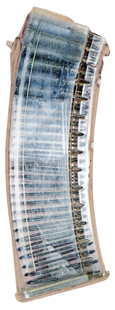
|
RUSSIAN IZHMASH CLEAR 30rd Description: Designed for the 5.45mm AK-74 Kalashnikov assault rifle. It is obvioiusly transparent and made from polycarbonate. Practical applications were never found for this magazine, so it never went past the prototype stage. (Photo courtesy of Kalashnikov Arms © 1997 Rosvoorouzhenie) |
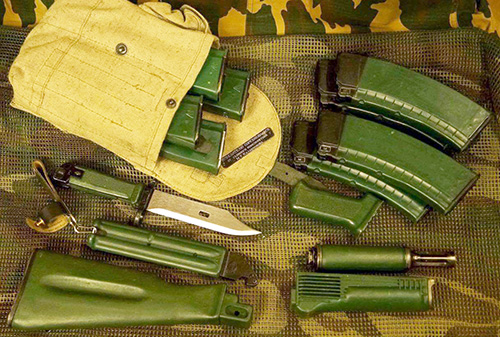
|
RUSSIAN IZHMASH GREEN BORDER GUARD 30rd Description: These unique green Izhmash magazines are made out of polymer with metal lip reinforcement, rear locking lug, and floorplate. They were produced for use by Russian border guards, and match rifles that are outfitted with green polyamide furniture. Quite a bit of "flaking," similar to what is found in plum magazines, has been observed in examples that have surfaced. (Photos courtesy of an anonymous donor on Facebook) |
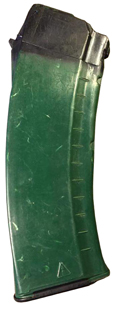
|
| EAST GERMAN BAKELITE 45rd Description: Generally similar to the Bulgarian/Russian design, but having the mold number on the right side and nothing on the left, in the manner of the 30rd magazines from the same country. To my knowledge, none have ever been imported into the US for sale, though a few examples may have entered mixed in with the more common Bulgarian magazines. (Photo courtesy of "The_Boy_Swift" on The AK Forum; East German mag on left, Molot mag on right) |
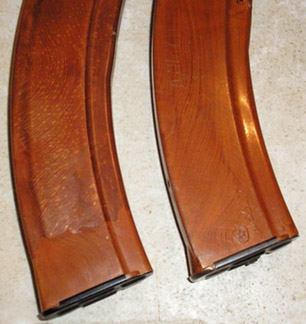
|
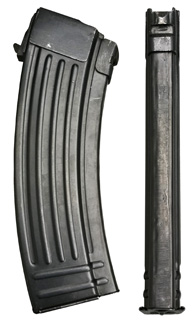
|
CHINESE 30rd Description: Norinco had plans to market a semi-auto AK-74 in the United States by the designation of 88S, but only a handful of sales samples (3 confirmed, possibly others) made it in before the 1989 assault rifle import ban was made permanent in July of that year. The subsequent Violent Crime Control and Law Enforcement Act of 1994, completely eliminated any further plans for Chinese AK-74s. The Chinese 5.45 magazines are steel and of a "flatback" design, lacking the dorsal spine found on the Polish and Romanian types. In November of 2006, one of these mags was sold for $180 by an individual in Switzerland on an AK-related internet forum. I have heard from a knowledgeable source that a small number had previously made it into the US in a similar manner, and that there were also a few sales samples in-country prior to the ban. (Photos courtesy of guns_in_switzerland on Instagram [magazine on left] and AK-47 & Kalashnikov Variation © 1993 Masami Tokoi [rifle on right]) |

|
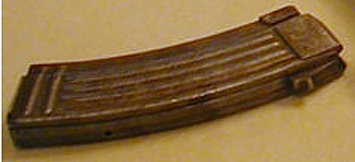
|
NORTH KOREAN 30rd Description: Very little is known about the North Korean AK-74 variant, save for what can be gleaned from propaganda photos and a couple of badly worn/corroded/damaged examples that have been recovered. It appears to use a steel 30rd magazine very similar to the Chinese pattern. (Photo courtesy of Rob Stott) |
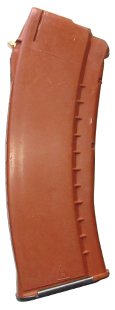
|
PAKISTANI "KHYBER PASS" IZHMASH POLYMER 30rd Description: A Pakistani near-clone of the Russian polymer 30rd magazine, fabricated by the provincial gunsmiths of the Afghanistan/Pakistan border regions as opposed to a state arsenal. These are constructed from red/orange polymer material (not Bakelite), and feature reinforcing ribs and floorplates nearly identical to the Russian style. There is even a reproduction of the Izhmash "arrow-in-triangle" arsenal mark on the bottom right side of the magazine body. The "Khyber Pass" magazines can be distinguished from genuine Izhmash magazines by the color and texture of the magazine body, a brass rear locking lug, and a unique (presumably Pakistani) arsenal mark in place of the mold number on the lower left side of the magazine body. This marking appears to be a triangular design featuring the letters "S G A" in stylized script. Magazines of this type have been seen alongside Pakistani built/modified AK-74 type rifles at the Royal Armory in England, and more recently, a few have been brought back by US troops returning from deployments to Iraq and Afghanistan. Black magazines of this type have also been documented. (Photos courtesy of Brian "AZAK" on the The AK Forum). |
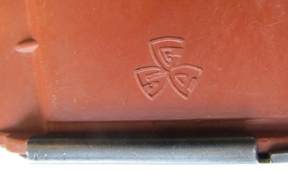 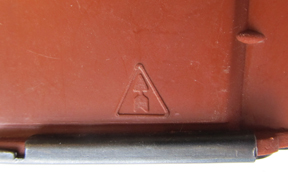
|
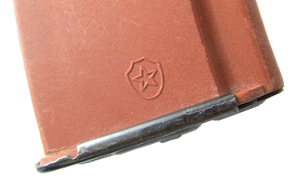 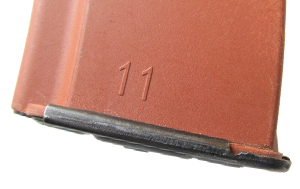
|
PAKISTANI "KHYBER PASS" MOLOT POLYMER 45rd Description: Like the Pakistani near-clone of the Russian polymer 30rd magazine above, this 45rd version is also fabricated by the provincial gunsmiths of the Afghanistan/Pakistan border regions as opposed to sanctioned state arsenals. It is constructed from red/orange polymer material (not Bakelite). With reinforcing ribs and floorplates almost identical to the Russian style. A copy of the Molot "star-in-shield" arsenal mark is featured on the bottom right side of the magazine body. The unit shown in the photos also includes a left side mold number (in this case '11') just like the original versions. The "Khyber Pass" magazines can be distinguished from genuine Molot magazines by the color and texture of the magazine body and a brass rear locking lug (often painted black). (Photos courtesy of Brian "AZAK" on the The AK Forum). |
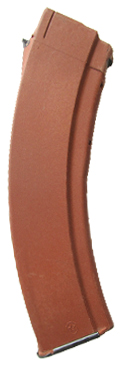
|
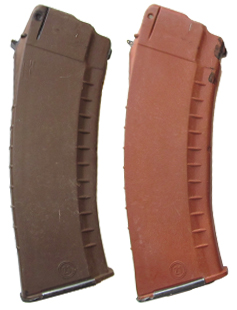
|
PAKISTANI "KHYBER PASS" CIRCLE 21 POLYMER 30rd Description: Like the Pakistani near-clone of the Russian polymer 30rd magazine is also fabricated by the provincial gunsmiths of the Afghanistan/Pakistan border regions as opposed to sanctioned state arsenals. It is constructed from red/orange or brown polymer material. With reinforcing ribs and floorplates almost identical to the Bulgarian variation. A copy of the NITI Kazanlak Code 21 (Circle 21) arsenal mark is featured on the bottom right side of the magazine body. The examples shown in the photos also include a left side mold number (in this case '1-1') just like the original versions. The "Khyber Pass" magazines can be distinguished from genuine Circle 21 magazines by the color and texture of the magazine body and a brass rear locking lug (often painted black). (Photos courtesy of Brian "AZAK" on the The AK Forum). |
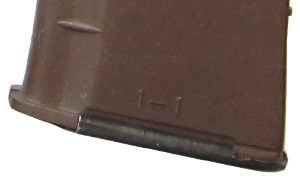 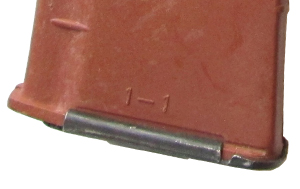
|
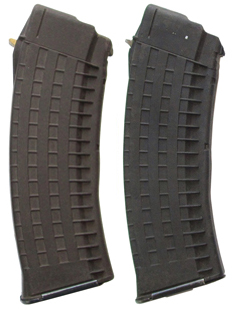
|
PAKISTANI "KHYBER PASS" MULTI-RIBBED POLYMER 30rd Description:This is a copy of the extremely rare Russian multi-ribbed plum polyamide pre-production magazine seen earlier in this section. Like the Pakistani near-clone of the Russian polymer 30rd magazine seen earlier, this version is also fabricated by the provincial gunsmiths of the Afghanistan/Pakistan border regions as opposed sanctioned state arsenals. It is constructed from brown or black polymer material (not plum polyamide like the originals). With reinforcing ribs and floorplates almost identical to the Russian style. The "Khyber Pass" magazines can be distinguished from genuine TsNIITochMash/Izhmash plum magazines they simulate by the color and texture of the magazine body and a brass rear locking lug (sometimes painted black). (Photos courtesy of Brian "AZAK" on the The AK Forum). |
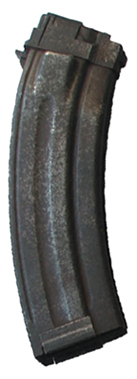
|
RUSSIAN PROTOTYPE STEEL QUAD STACK 60rd Description: Almost nothing is known about this magazine other than it supposedly exists. The only reference found to date is an image in a Russian article covering the history of the 5.45x39mm cartridge. This mag is tentatively the rarest of the rare. (Left: Photo acquired from Part 2: A Difficult Destiny) |
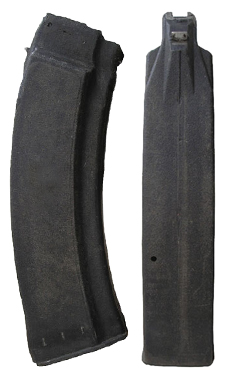
|
RUSSIAN QUAD STACK 60rd Description: The origins of this unusual polymer magazine are unclear, but it has been seen featured on the AK-12 in many photos found on the Internet. Essentially two 30rd magazines fused together, the quad stack features "blown out" sides tapering down to a standard double-column feed neck, with dual springs and followers inside. Pictures and engineering drawings of this magazine have been circulating around the Internet for some time. Rarely seen even in Russia, these barely progressed beyond the prototype stage due to feed problems. This led to the 50rd version documented below. The one shown in the photo to the left is likely an early prototype, with others like the one seen to the right bearing an Izhmash logo on the bottom right side like standard magazines. At least one made its way to the US, which sold for a substantial sum. (Left: Photo acquired from an article covering history of the 5.45x39 round Part 2: A Difficult Destiny. Right: Photo courtesy of Joe Ancona and Jason Jeffers) |
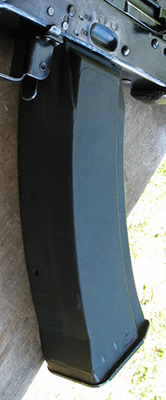
|
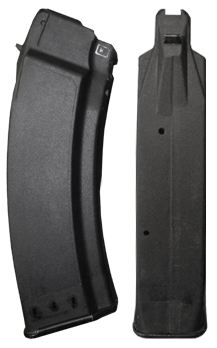
|
RUSSIAN QUAD STACK 50rd Description: The 50rd quad stack is the result of testing that showed the 60rd quad had a tendency to fail feeding the last 10 rounds if stored fully loaded for extended periods of time. It is only slightly taller than a 30rd mag, but considerably fatter, of course. It remains a good deal shorter than its 60rd brother. Several of these have made it into the US, with photos of the internals available via search on the Internet.(Photo courtesy of RussianOptics.net) |
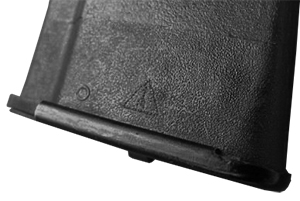
|
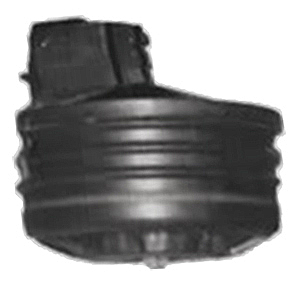
|
RUSSIAN RPK-74 PAN DRUM Description: This experimental drum magazine for the RPK-74 locks into the gun in the manner of a normal 30rd magazine, but the drum body is oriented almost parallel to the barrel (rather than vertically or angled slightly forward as with the 7.62x39 drums). It features a radial arrangement of cartridges with bullet tips toward the magazine center, and along a spiral from the floor plate to the follower. Polymer and metal construction with a capacity of 90 rounds. This drum ultimately proved impractical. Its production was cancelled not only because of manufacturing problems, but also because the machine gun was not comfortable to hold. A few photos have been widely circulated, and urban legend has it that one of the prototypes sold on the internet for around $3500. (Right and left: Photos found on the internet. Right photo shows drum mounted to a PU-1 experimental light machine gun, which could be fed by belts or magazines.) |
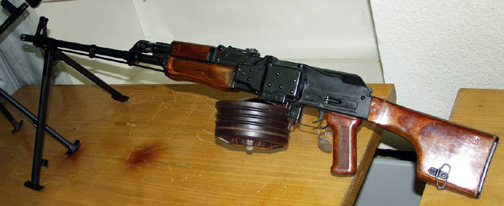
|
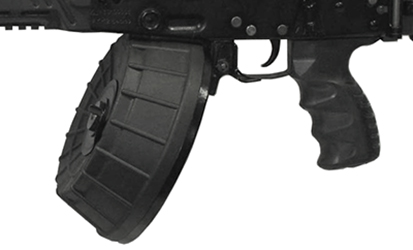
|
RUSSIAN POLYMER DRUM Description: The origins of this polymer drum remain unclear. They have surfaced in Eastern Europe for sale by vendors there, and one appears in a Larry Vickers video filmed in Russia during late 2015. The unit shown here was mounted on an AK-12 on display at an Izhmash table during a weapons show in Russia. (Photos courtesy of an anonymous source on the Internet) |
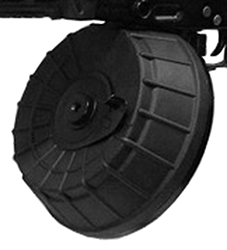
|